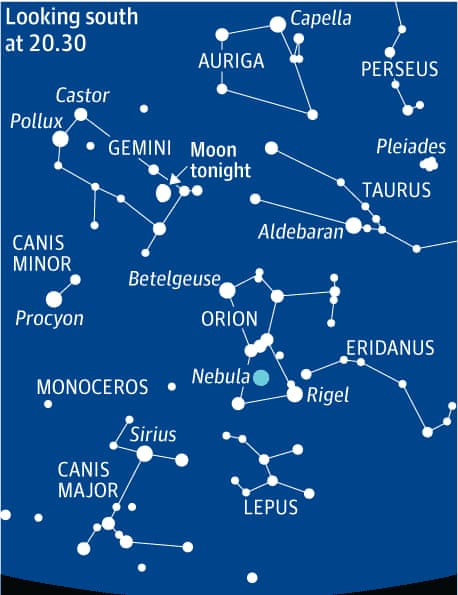If you plan a Valentine's Day rendezvous under the stars this evening then, weather permitting, you should also be able to savour our best evening sky of the year.
Our chart plots the southern sky from horizon to zenith at the Orion Hour, the time when that most spectacular of constellations stands at its highest on the meridian. The vista includes Sirius, the brightest star, Gemini, Taurus and the Pleiades, and the yellowish gleam of Capella overhead. It is true that the Moon lies near the feet of Gemini, its light swamping the fainter stars, but the true romantic might regard that as a bonus.
The constellation figure of the Hunter is one of the few that bears some resemblance to what it represents. Orion has a distinctive line of three stars around his waist, Orion's Belt, and stars to mark his shoulders and knees. He has a knot of lesser stars for a head and a line of them to the right as a shield with which he defends himself against the charging bull Taurus. Though its stars are too dim for our chart, he wields a club above his head and a line of stars hangs below his Belt to represent Orion's Sword.
It is here in the Sword that we find the Orion Nebula, the glowing cloud of gas and dust that is the best studied region of new star and planet formation in the sky. It may be glimpsed by the naked eye, but is much easier through binoculars, particularly when the Moon is around. Recent studies place it some 1,344 light years (ly) away, a little beyond Orion's main stars. Indeed, it is rather like a blister on the flank of a cloud of material, mostly dark and cold, that blankets the distant regions of the entire constellation and is called the Orion Molecular Cloud.
The red supergiant Betelgeuse and the contrasting blue supergiant Rigel are Orion's brightest stars, with Betelgeuse pulsating erratically and usually fainter than Rigel. They lie perhaps 640 ly and 780 ly away respectively, give or take more than 100 ly, and each is thought to be 17-19 times more massive than our Sun. They are also tens of thousands of times more luminous and neither can live for much more than 10 million years before exploding in a type II supernova, scattering its ashes back into space.
Betelgeuse appears to be the most evolved and there has been recent tabloid speculation that it might go supernova any day now, turning night into day as a second sun appears in the sky for a few weeks. In fact, the explosion may not occur for a million years; and even if it were to come today, it might shine no brighter than tonight's Moon.

Comments (…)
Sign in or create your Guardian account to join the discussion